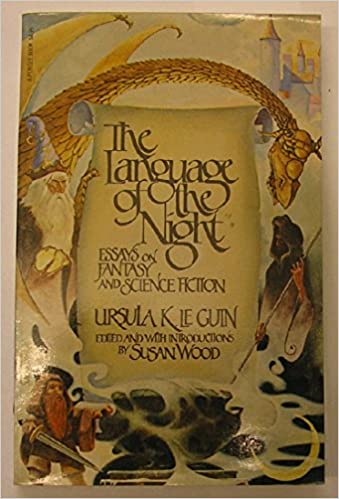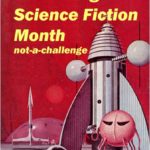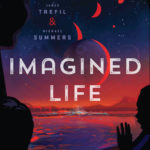When I started this blog, I considered having a page offering various answers to the question, What is science fiction? There are so many different, often clashing views that I thought that would be interesting, but I eventually rejected the idea because it seems too pedantic to even suggest that there is or ought to be a “correct” answer. So instead, I’m going to examine the ideas about science fiction that some of the best writers have offered, not as definitions but as reflections on their chosen genre for expressing who they are as writers.
Ursula K. Le Guin’s approach to answering the question What is science fiction? was to fight hard to elevate the genre from pulp to fiction. Or, as she unforgettably put it in one of the essays collected in The Language of the Night, (Perigee/Putnam 1979) she no longer wanted to see Philip K. Dick’s work on the library shelf next to Barf the Barbarian by Elmer T. Hack but next to Charles Dickens where it belonged (p 227). She thought science fiction had been through its childhood and adolescence and deserved to be taken seriously as fiction, and that’s a great starting point.
In “The Modest One” (1976) she elaborated on her comparison of Dick and Dickens. They both kept “a direct line open to the unconscious.” It’s easy to remember the vivid characters in Dickens’ books but not always the titles of the novels in which they appear. That is because, she writes, the characters make a powerful psychic imprint that clearly comes out of Dickens’ universe. So it is with Dick’s work. Themes and motifs are repeated and help define his particular sense of reality and often the fragile boundary between different levels of reality or between anchored sanity and madness.
She admired Dick’s work, especially when he was in full control of his material plumbing the depths of consciousness, because he was telling the story of slipping out of reality from the inside. His approach to science fiction was not to save humanity from tentacled monsters somewhere in the galaxy but to narrate the saving of a human soul. Perhaps that was a modest goal for science fiction, but Le Guin considered it no less powerful and earthshaking.
In “Myth and Archetype in Science Fiction” (1976) she tackled the grander themes that underlie the appeal of the genre for many readers. Here she sets a very high standard for the true artists of science fiction. She sorts through the false ideas of mythology, then hits on its origins in our own psyches. Myth is not primitive science, no longer necessary because we have a more rational understanding of nature. Nor is it a bunch of intellectualized symbols concealing abstract meaning. Nor is it the subrational drives that people can follow by giving in wholly to irrationality, as a good fraction of our population is doing right now.
Myth rather flows from the unconscious, she believed, not as specific beings or structures but as elemental forces that can take many shapes. It is the work of the artist, in science fiction or other media, to connect the conscious world with these unconscious forces. It took a Mary Shelley to loose Frankenstein’s monster on the world, and he is still with us. Tolkien did it with his ring of power, and Karel Čapek did it by naming the “robot” that arose from the separation of mind and body, ghost and machine.
Artists can only do this, Le Guin argued, by going inside the self where they can link with the inner realities that Jung referred to as collective. The connections between conscious and unconscious are the stuff of true myth, and only when those are made can science fiction be called the mythology of the modern world. Just lifting a story from one of the many mythologies from around the world won’t do it. That is simply theft, Le Guin says. It takes the deep probing of self and world that only a few artists really achieve. I wonder how she regarded her works in this light.
My personal favorite among the many great essays of The Language of the Night (if only this were still in print!) is “Science Fiction and Mrs. Brown” (1976). It starts with a quotation from Virginia Woolf, especially fitting since that is the neighborhood of mind and artistry in which she wanted to locate good science fiction. Woolf’s essay of the 1920s described a woman she called Mrs Brown whom she had sat opposite in a railway carriage. In a paragraph, Woolf captured a fully rounded character that makes her unforgettable. The point of the essay was to challenge the writers of her day who were preoccupied with social mores and external forces that controlled people’s lives. They didn’t write novels so much as sociology. Woolf asked if there was a place in such fiction for Mrs. Brown, a fully realized character who can take center stage because of the human qualities she embodies. In other words, is there still room for a novel of character?
Le Guin asks the same question of the science fiction community. For her, character was everything. Much as she respected the genre for its variety and ability to generate metaphors for our own strange times, she thought all the galaxies, space ships, aliens and laser weapons were useless props or trash if there was no human subject in the center of it all. Science fiction, she thought, too often settled for the superficial marvels, wonders and horrors with nothing beyond themselves and without moral resonance.
“…the work of people from Zamiatin to Lem has shown that when science fiction uses its limitless range of symbol and metaphor novelistically, with the subject at the center, it can show us who we are, and where we are, and what choices face us, with unsurpassed clarity, and with a great and troubling beauty.”
The Language of the Night, Perigee/Putnam paperback edition, p. 118
So for Le Guin, the question is not really What is science fiction? It is rather a challenge to SFF writers to go beyond the tropes of the genre to connect with what is most human wherever in the universe they may choose to locate it. Science fiction offered a promise for the “continued life of the imagination” and an “enlargement of consciousness, a possible glimpse, against a vast dark background, of the very frail, very heroic figure of Mrs. Brown.” (p. 119) She suggested a simple test for an SFF novel. After reading it, can you remember the names of the characters or anything about them? I think it’s a good way of measuring whether they made a human impact or only filled a slot in a story. Science fiction, for Le Guin, is about us or it’s about nothing.





Big cringe tbh. SF should be about space adventurers beating up monsters and boning princesses.
Guess there’s a lot of SF these days you won’t be reading.
Thank you so much for this 🙂
I read “The Language of the Night” many years ago and have never forgotten Mrs. Brown.
I remember Ursula le Guin’s statement;
” Story is how we tell ourselves who we are.”
This may be an imperfect rendering, but I feel it is true to her meaning. Remembering our humanity, individually and universally, may be the only thing that keeps us from destroying ourselves. And all the many lives with whom we share this world
Thanks for writing, Adam. I’ve gotten hold of another book of Le Guin’s essays, Dancing at the Edge of the World, and will soon be writing more about her views of writing and science fiction.
I love science fiction. I love to write science fiction, poetry and satire. Some of my fave books and films are sci-fi.